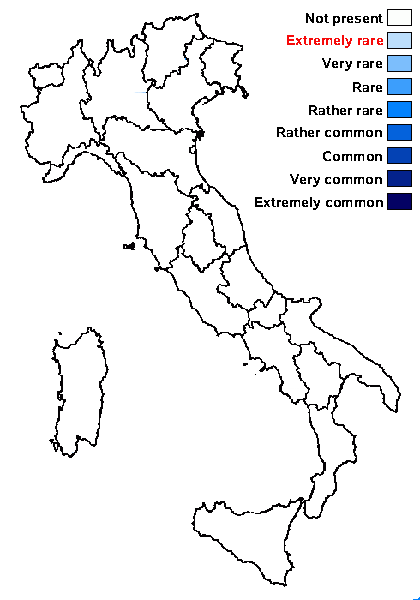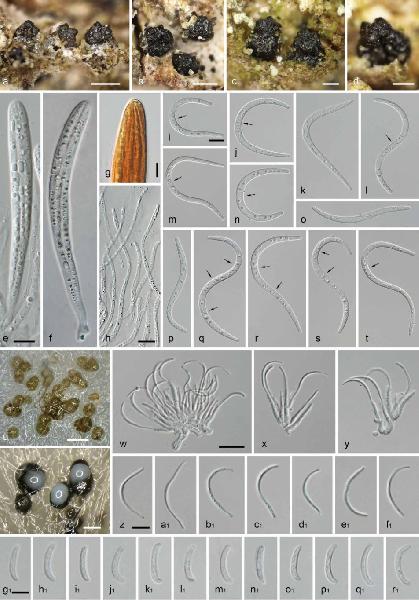Leptosillia macrospora (Eitner) Voglmayr & Jaklitsch
in Voglmayr & al., Persoonia, 42: 245, 2019. Basionym: Leptorhaphis quercus f. macrospora Eitner - Jber. schles. Ges. vaterl. Kultur, 78, 2b: 25, 1901
Synonyms: Cresporhaphis macrospora (Eitner) M.B. Aguirre
Distribution:
Description: Thallus inapparent, not lichenized, developing on bark of living trunks of Quercus. Perithecia black, half-immersed to superficial, (0.17-)0.2-0.25(-0.27) μm across, smooth, scattered singly or gregarious, pyriform, circular from above, sometimes laterally collapsed, with a central apical papilla laterally enlarged by stellate or sulcate structures. Exciple continuous, dark brown, becoming hyaline towards the centrum, 20-30 μm thick, of a textura angularis composed of thin-walled, isodiametrical to elongated cells with subhyaline to dark brown walls. Paraphyses hyaline, smooth, thin-walled, septate, rarely branched, 1.5-3.3 μm thick, embedded in a I- gelatinous matrix. Asci 8-spored, cylindrical-clavate, unitunicate, thin-walled, without a distinct apical apparatus. Ascospores 1-3-septate, hyaline, sinuous, sigmoid, semicircular to hook-shaped, (53-)65-93(-109) x (3-)3.5-4.5(-5) μm, thin-walled, smooth, with narrowly rounded ends, multiguttulate. Pycnidia scattered, black, slightly smaller than the perithecia (c. 0.1-0.15 mm across. Conidia 1-celled, hyaline, threadlike, (16-)18-23(-24) x (0.8-)0.9-1.1(-1.2) μm. Photobiont absent. Spot tests: all negative. Chemistry: without lichen substances.Note: on bark of living trunks of Quercus known from Austria, Croatia, Czech Republic, Germany, Hungary, Poland, Sweden, and Switzerland; to be looked for in Italy.
Growth form: Fungus
Substrata: bark
Reproductive strategy: mainly sexual
Pioneer species

Predictive model

Source: Voglmayr H., Aguirre-Hudson M.B., Wagner H.G., Tello S., Jaklitsch W.M. 2019. Lichens or endophytes? The enigmatic genus Leptosillia in the Leptosilliaceae fam. nov. (Xylariales), and Furfurella gen. nov. (Delonicicolaceae). Persoonia, 42: 228–260. - CC BY-NC-ND 3.0
a–d. Perithecia on bark; note the stellate or sulcate structures on the apical papillae; e–f. asci in 3 % KOH; g. ascus tip in
Lugol; h. paraphyses; i–t. vital ascospores; arrows denoting septa; u–v. pycnidia and conidial drops in culture (CMD, isolation plate, 7 d); w–y. conidiophores,
conidiogenous cells and conidia from pycnidia on natural substrate; z–f1. conidia from natural substrate; g1–r1. conidia from pycnidia in culture (CMD, 6 mo).
All in water, except where noted (a–b, i–l, n–p, w–f1: WU 39999 (epitype); c–f: WU 40004; g–h, m, q–t: WU 40000; u–v, g1–r1: CRM2). — Scale bars:
a–b, u = 200 μm; c–d, v = 100 μm; e–f, h–t, w–y = 10 μm; g, z–r1 = 5 μm.
Growth form: Fungus
Substrata: bark
Reproductive strategy: mainly sexual
Pioneer species

Predictive model

 INDEX FUNGORUM
INDEX FUNGORUM
 GBIF
GBIF

